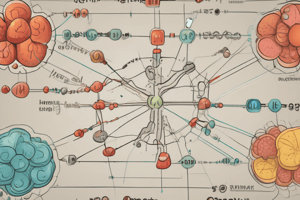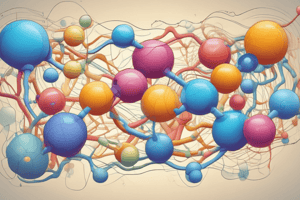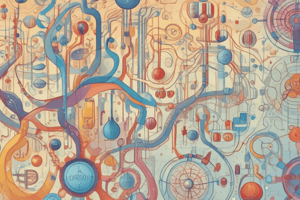Podcast
Questions and Answers
Who holds the position of Head of Department?
Who holds the position of Head of Department?
- Assistant Prof. Dr. Abeer Ahmed Alrefai
- Dr. Shereen Sobhy
- Assistant Prof. Dr. Shereen Sobhy
- Prof. Dr. Abeer Ahmed Alrefai (correct)
What is the title of Dr. Abeer Ahmed Alrefai?
What is the title of Dr. Abeer Ahmed Alrefai?
- Associate Professor
- Professor
- Assistant Professor (correct)
- Head of Department
Which title is held by Dr. Shereen Sobhy?
Which title is held by Dr. Shereen Sobhy?
- Head of Department
- Associate Professor
- Department Chair
- Assistant Professor (correct)
Which role is associated with Prof. Dr. Abeer Ahmed Alrefai?
Which role is associated with Prof. Dr. Abeer Ahmed Alrefai?
What is the primary purpose of glycolysis?
What is the primary purpose of glycolysis?
Which of the following pairs correctly identifies the roles of the two individuals mentioned?
Which of the following pairs correctly identifies the roles of the two individuals mentioned?
How much ATP is produced through anaerobic glycolysis?
How much ATP is produced through anaerobic glycolysis?
In aerobic glycolysis, how many ATP molecules are generated?
In aerobic glycolysis, how many ATP molecules are generated?
Which process generates more ATP, anaerobic or aerobic glycolysis?
Which process generates more ATP, anaerobic or aerobic glycolysis?
What are the two types of glycolysis mentioned?
What are the two types of glycolysis mentioned?
What do metabolic reactions inside the body primarily involve?
What do metabolic reactions inside the body primarily involve?
What is the main metabolic process that occurs in tissues with frequent oxygen lack?
What is the main metabolic process that occurs in tissues with frequent oxygen lack?
Which term best describes the total chemical reactions involved in maintaining the living state of the cells?
Which term best describes the total chemical reactions involved in maintaining the living state of the cells?
What are metabolic processes fundamentally concerned with?
What are metabolic processes fundamentally concerned with?
What is the first stage of the metabolic process described?
What is the first stage of the metabolic process described?
How many molecules of glyceraldehyde-3-P are produced from one molecule of glucose?
How many molecules of glyceraldehyde-3-P are produced from one molecule of glucose?
Which of the following is NOT a component of metabolism?
Which of the following is NOT a component of metabolism?
Which of the following tissues is especially affected by oxygen lack during exercise?
Which of the following tissues is especially affected by oxygen lack during exercise?
How would you describe the relationship between catabolic and anabolic reactions in metabolism?
How would you describe the relationship between catabolic and anabolic reactions in metabolism?
What is the primary outcome of the energy requiring step in the metabolic process?
What is the primary outcome of the energy requiring step in the metabolic process?
Which two sources contribute to energy production in the body?
Which two sources contribute to energy production in the body?
In which organ is 90% of energy production primarily located?
In which organ is 90% of energy production primarily located?
Where does the majority of energy production occur at the cellular level?
Where does the majority of energy production occur at the cellular level?
What percentage of energy production occurs in the kidneys?
What percentage of energy production occurs in the kidneys?
Which of the following is NOT listed as a source for energy production?
Which of the following is NOT listed as a source for energy production?
What is propionate specifically converted into during metabolism?
What is propionate specifically converted into during metabolism?
Where does glycerol primarily come from during fasting?
Where does glycerol primarily come from during fasting?
In which type of animal does propionic acid metabolism occur?
In which type of animal does propionic acid metabolism occur?
What role does lactate play in energy metabolism?
What role does lactate play in energy metabolism?
What is the primary fate of glycerol following its release from adipose tissue during fasting?
What is the primary fate of glycerol following its release from adipose tissue during fasting?
Flashcards
Assistant Professor
Assistant Professor
A professor who assists senior professors and teaches classes.
Head of Department
Head of Department
The person in charge of a specific department.
Dr. Abeer Ahmed Alrefai's Title
Dr. Abeer Ahmed Alrefai's Title
Assistant Professor and Head of Department
Dr. Shereen Sobhy's Title
Dr. Shereen Sobhy's Title
Signup and view all the flashcards
Professor
Professor
Signup and view all the flashcards
Metabolism
Metabolism
Signup and view all the flashcards
Chemical reactions
Chemical reactions
Signup and view all the flashcards
Synthesis
Synthesis
Signup and view all the flashcards
Breakdown
Breakdown
Signup and view all the flashcards
Enzymes
Enzymes
Signup and view all the flashcards
Glycolysis energy production
Glycolysis energy production
Signup and view all the flashcards
Anaerobic glycolysis ATP
Anaerobic glycolysis ATP
Signup and view all the flashcards
Aerobic glycolysis ATP
Aerobic glycolysis ATP
Signup and view all the flashcards
Glycolysis
Glycolysis
Signup and view all the flashcards
Importance of Glycolysis
Importance of Glycolysis
Signup and view all the flashcards
Oxygen Lack in Tissues
Oxygen Lack in Tissues
Signup and view all the flashcards
Glycolysis Stage 1
Glycolysis Stage 1
Signup and view all the flashcards
Glucose
Glucose
Signup and view all the flashcards
Glyceraldehyde-3-P
Glyceraldehyde-3-P
Signup and view all the flashcards
Glycogenesis
Glycogenesis
Signup and view all the flashcards
Gluconeogenesis
Gluconeogenesis
Signup and view all the flashcards
Lactic acid
Lactic acid
Signup and view all the flashcards
Pyruvic acid
Pyruvic acid
Signup and view all the flashcards
Propionic acid
Propionic acid
Signup and view all the flashcards
Lactate Metabolism
Lactate Metabolism
Signup and view all the flashcards
Propionate Metabolism in Ruminants
Propionate Metabolism in Ruminants
Signup and view all the flashcards
Glycerol Metabolism
Glycerol Metabolism
Signup and view all the flashcards
Cori Cycle
Cori Cycle
Signup and view all the flashcards
Succinyl CoA
Succinyl CoA
Signup and view all the flashcards
Study Notes
Biochemistry 1 For Technologists
- Biochemistry and Molecular Biology department, Faculty of Medicine, Menoufia University, 2024-2025
- Course covers metabolism, including carbohydrate, lipid, and protein metabolism.
Metabolism
- Chemical energy (carbohydrates, fats, proteins, others) is the body's energy currency (ATP).
- Chemical waste (carbon dioxide, water) is generated.
- Heat is produced.
Table Content (Page 1 details)
- Overall aims of the course.
- Learning objectives for each chapter. (Carbohydrate, Lipid, and Protein metabolism)
- Different metabolic pathways.
- Blood glucose regulation and related issues (hypoglycemia, hyperglycemia, and glucosuria).
- Revision questions.
Studying That Suits You
Use AI to generate personalized quizzes and flashcards to suit your learning preferences.




